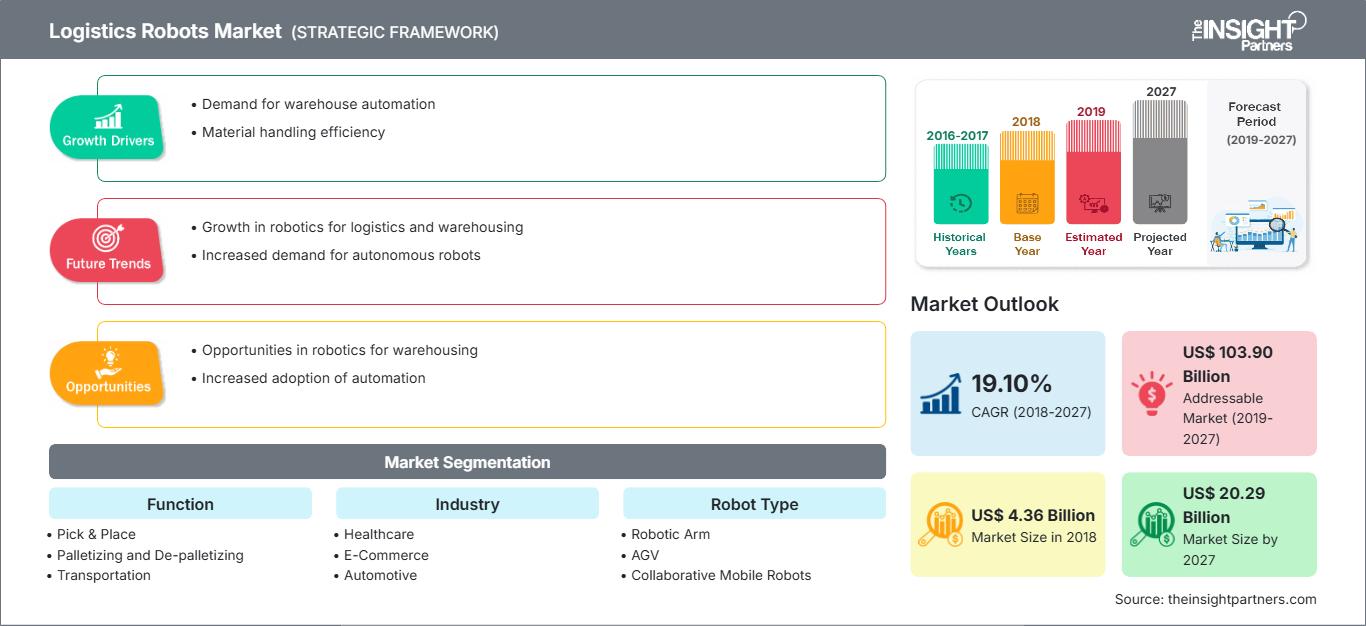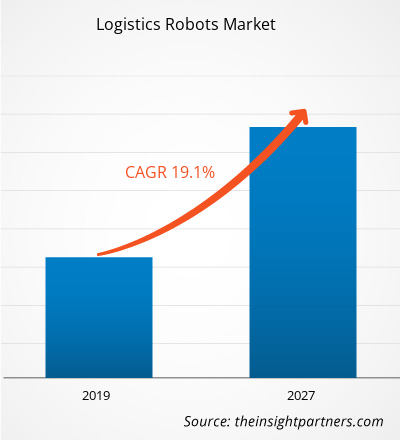Der Markt für Logistikroboter wurde 2018 auf 4.356,2 Millionen US-Dollar geschätzt und soll von 2019 bis 2027 mit einer durchschnittlichen jährlichen Wachstumsrate von 19,10 % wachsen und bis 2027 20.293,4 Millionen US-Dollar erreichen.
Immer mehr Logistik- und Lagerunternehmen setzen verstärkt auf den Einsatz von Robotern, um von verbesserter Effizienz, Geschwindigkeit und höheren Gewinnen zu profitieren und so auf dem Markt wettbewerbsfähig zu bleiben. Die Einführung fortschrittlicher Technologien wie robotergestützter Lager- und Logistiktechnologien nimmt zu, um die Betriebseffizienz zu erschwinglichen Preisen zu verbessern. Der globale Markt für Logistikroboter wird von Faktoren wie der zunehmenden Alterung der Bevölkerung, die zu Arbeitskräftemangel führt, und der Ausweitung der Lieferkettennetzwerke weltweit getrieben. Hohe Investitionen in den Einsatz von Logistikrobotern dürften das Marktwachstum des Marktes für Logistikroboter im Prognosezeitraum jedoch bremsen. Die zunehmende Automatisierung der Lagerhäuser und die gut etablierten Märkte in den Ländern Asien-Pazifik und Europa werden den Akteuren der Branche in naher Zukunft jedoch voraussichtlich erhebliche Wachstumschancen bieten und ihnen so die Möglichkeit geben, ihren Marktanteil zu verbessern.
Markteinblicke: Wachsender Anteil der alternden Bevölkerung führt weltweit zu Arbeitskräftemangel
Der weltweit wachsende Anteil der alternden Bevölkerung ist einer der Hauptfaktoren für den Arbeitskräfteabbau in zahlreichen Branchen. In jedem Land der Welt steigt die Zahl älterer Menschen. Die Alterung der Bevölkerung ist zu einem der wichtigsten Faktoren für den gesellschaftlichen Wandel im 21. Jahrhundert in allen Sektoren geworden, sowohl auf dem Arbeitsmarkt als auch auf den Finanzmärkten. Allerdings sind Länder wie Italien, Japan und viele andere die Länder mit dem höchsten Anteil an alternder Bevölkerung, wenn man bedenkt, dass ein erheblicher Prozentsatz ihrer Bevölkerung über 65 Jahre alt ist. Laut WHO werden bis zum Jahr 2050 weltweit voraussichtlich rund 2 Millionen Menschen über 60 Jahre alt sein, was einer Verdreifachung gegenüber dem Jahr 2000 entspricht. Der starke Anstieg der alternden Bevölkerung ist für den Arbeitskräftemangel verantwortlich. Der Einsatz von Logistikrobotern spielt in verschiedenen Branchen eine wichtige Rolle, da er die Gesamtkosten des Prozesses senkt, die Produktivität steigert, die Sicherheit erhöht und menschliche Fehler reduziert. Der rasante technologische Fortschritt in Lagern weltweit konzentriert sich auf die Anforderungen im Zusammenhang mit den Schwierigkeiten der Lieferkettenprozesse und stellt sicher, dass die eingesetzte Technologie mit den Geschäftszielen in Einklang steht. Der Einsatz von Robotern in verschiedenen Einheiten, Funktionen und Phasen des Produktlebenszyklus ist eine zentrale Herausforderung für Lagerhäuser auf ihrem Wachstumspfad, was wiederum den Markt für Logistikroboter in naher Zukunft ankurbeln wird.
Passen Sie diesen Bericht Ihren Anforderungen an
Sie erhalten kostenlos Anpassungen an jedem Bericht, einschließlich Teilen dieses Berichts oder einer Analyse auf Länderebene, eines Excel-Datenpakets sowie tolle Angebote und Rabatte für Start-ups und Universitäten.
Markt für Logistikroboter: Strategische Einblicke

-
Holen Sie sich die wichtigsten Markttrends aus diesem Bericht.Dieses KOSTENLOSE Beispiel umfasst Datenanalysen, die von Markttrends bis hin zu Schätzungen und Prognosen reichen.
Das Segment der kollaborativen mobilen Roboter hat den größten Anteil am globalen Markt für Logistikroboter. Sie werden branchenübergreifend für verschiedene Aufgaben wie Verpackung, Maschinenbedienung und Materialhandhabung eingesetzt, da diese Cobots sowohl für schwere als auch für leichte Aufgaben geeignet sind. Sie arbeiten hochpräzise, flexibel und präzise. Darüber hinaus sind Cobots wartungsfreundlich und lassen sich leichter neu konfigurieren und programmieren. Diese Roboter können auch sensible Arbeiten übernehmen und passen sich zudem an Inkonsistenzen im Fertigungsprozess an. Cobots erfassen wichtige Messdaten für Onboard-Analysen und Berichte, um den Entscheidungsprozess zu vereinfachen und den gesamten Markt für Logistikroboter voranzutreiben.
Funktionseinblicke
Das Transportsegment hat den größten Anteil am globalen Markt für Logistikroboter. Die Waren werden palettiert, und es gibt leichte Unterschiede bei verschiedenen Produktformen und -größen, was eine Automatisierung des Be- und Entladens dieser Waren erforderlich macht. Die 3D-Laservision ist in die neue Robotersoftware integriert, die den Benutzern die Sichtbarkeit verschiedener Produkte in Behältern ermöglicht, die ideale Be-/Entladereihenfolge bestimmt und den Prozess mit hoher Genauigkeit durchführt. Logistikrobotik wird zum Bewegen von Zielregalen, Ziehen und Anheben von Körben, Ausstrecken der Gabel im Regal und Zurückbringen zur Zielposition eingesetzt und treibt den gesamten Markt für Logistikroboter an.
Brancheneinblicke
Das Segment der ausgelagerten Logistik hat den größten Anteil am globalen Markt für Logistikroboter. Diese Logistikdienstleister bieten verschiedene Dienstleistungen an, darunter Lagerhaltung, Bestandsverwaltung, Transport, Vertrieb, Auftragsabwicklung und Frachtkonsolidierung. Die ständig steigende Nachfrage nach zeitnahem Liefermanagement sowie nach reduzierten Versandkosten, die verstärkte Konzentration auf die Bestandserfassung von Materialien und das Kerngeschäft sowie die Reduzierung des Unternehmensvermögens werden den Markt für Logistikroboter im Prognosezeitraum voraussichtlich antreiben.
Unternehmen verfolgen häufig verschiedene Marktinitiativen, um ihre Präsenz weltweit auszubauen und die wachsende Nachfrage zu decken. Diese Strategie ist vor allem in Europa und der Asien-Pazifik-Region zu beobachten. Die Akteure auf dem Markt für Logistikroboter verfolgen eine Strategie der Expansion und Investitionen in Forschung und Entwicklung, um ihren Kundenstamm weltweit zu vergrößern und ihren Markennamen global zu behaupten.
Regionale Einblicke in den Markt für Logistikroboter
Die Analysten von The Insight Partners haben die regionalen Trends und Faktoren, die den Markt für Logistikroboter im Prognosezeitraum beeinflussen, ausführlich erläutert. In diesem Abschnitt werden auch die Marktsegmente und die geografische Lage in Nordamerika, Europa, dem asiatisch-pazifischen Raum, dem Nahen Osten und Afrika sowie Süd- und Mittelamerika erörtert.
Umfang des Marktberichts zu Logistikrobotern
| Berichtsattribut | Einzelheiten |
|---|---|
| Marktgröße in 2018 | US$ 4.36 Billion |
| Marktgröße nach 2027 | US$ 20.29 Billion |
| Globale CAGR (2018 - 2027) | 19.10% |
| Historische Daten | 2016-2017 |
| Prognosezeitraum | 2019-2027 |
| Abgedeckte Segmente |
By Funktion
|
| Abgedeckte Regionen und Länder |
Nordamerika
|
| Marktführer und wichtige Unternehmensprofile |
|
Dichte der Marktteilnehmer für Logistikroboter: Auswirkungen auf die Geschäftsdynamik verstehen
Der Markt für Logistikroboter wächst rasant. Die steigende Nachfrage der Endnutzer ist auf Faktoren wie veränderte Verbraucherpräferenzen, technologische Fortschritte und ein stärkeres Bewusstsein für die Produktvorteile zurückzuführen. Mit der steigenden Nachfrage erweitern Unternehmen ihr Angebot, entwickeln Innovationen, um den Bedürfnissen der Verbraucher gerecht zu werden, und nutzen neue Trends, was das Marktwachstum weiter ankurbelt.

- Holen Sie sich die Markt für Logistikroboter Übersicht der wichtigsten Akteure
- Roboterarm
- AGV
- Kollaborative mobile Roboter
- Sonstige
Markt für Logistikroboter – nach Funktion
- Pick & Place
- Palettieren und Depalettieren
- Transport
- Verpackung
Markt für Logistikroboter – nach Branche
- Gesundheitswesen
- E-Commerce
- Automobilindustrie
- Outsourcen von Logistik
- Einzelhandel
- Konsumgüter
- Lebensmittel und Getränke
- Sonstige
Markt für Logistikroboter – Nach Geografie
-
Nordamerika
- USA
- Kanada
- Mexiko
-
Europa
- Frankreich
- Deutschland
- Italien
- Großbritannien
- Russland
- Rest von Europa
-
Asien-Pazifik
- China
- Indien
- Südkorea
- Japan
- Australien
- Rest des Asien-Pazifik-Raums
-
Naher Osten und Afrika
- Südafrika
- Saudi-Arabien
- VAE
- Rest des Nahen Ostens und Afrika
-
Südamerika
- Brasilien
- Argentinien
- Rest Südamerika
Firmenprofile
- AGV International
- Clearpath Robotics
- Daifuku Co. Ltd.
- Fanuc Corporation
- Fetch Robotics Inc.
- Kion Group AG
- KNAPP AG
- Kollmorgen
- KUKA AG
- Toshiba Corporation
- Historische Analyse (2 Jahre), Basisjahr, Prognose (7 Jahre) mit CAGR
- PEST- und SWOT-Analyse
- Marktgröße Wert/Volumen – Global, Regional, Land
- Branchen- und Wettbewerbslandschaft
- Excel-Datensatz
Aktuelle Berichte
Verwandte Berichte
Erfahrungsberichte
Grund zum Kauf
- Fundierte Entscheidungsfindung
- Marktdynamik verstehen
- Wettbewerbsanalyse
- Kundeneinblicke
- Marktprognosen
- Risikominimierung
- Strategische Planung
- Investitionsbegründung
- Identifizierung neuer Märkte
- Verbesserung von Marketingstrategien
- Steigerung der Betriebseffizienz
- Anpassung an regulatorische Trends






















 Kostenlose Probe anfordern für - Markt für Logistikroboter
Kostenlose Probe anfordern für - Markt für Logistikroboter